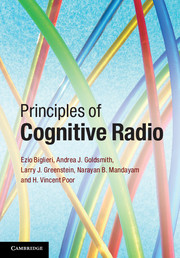4 - Spectrum sensing
Published online by Cambridge University Press: 05 December 2012
Summary
Introduction
As discussed in Chapter 2, cognitive radio (CR) aims at maximizing the throughput of secondary users coexisting with primary users under a noninterference or a limitedinterference assumption. Both assumptions require the secondary user to collect cognition about the radio environment, or spectrum sensing. Here the concept of spectrum space is extended to multiple dimensions, such as time, space, frequency, and code, and sensing may include not only detecting and classifying the regions of the spectrum space that can be used by secondary users, but also determining what type of signals are occupying the spectrum, including modulation, waveform, bandwidth, carrier frequency, etc. [50]. All these operations assume that the primary user is not aware of the presence of a secondary user.
Spectrum sensing classifies spectrum spaces as follows:
white space, one which is completely empty, except for noise;
gray space, one which is partially occupied by interfering signals;
black space, one which is fully occupied by communication signals, interfering signals, and noise.
With reference to the CR paradigms categorized in Chapter 2, white spaces are relevant to interweaving, which allows secondary users to operate in spectrum regions that are unused, gray spaces to underlaying, which tries to keep the interference on the primary user at a tolerable level, and black spaces to overlaying, where the primary user transmission is overheard, and signals are processed in a way that makes the quality of this transmission unimpaired by the secondary user.
In this chapter we examine spectrum sensing for application to the first two paradigms.
- Type
- Chapter
- Information
- Principles of Cognitive Radio , pp. 150 - 183Publisher: Cambridge University PressPrint publication year: 2012
- 3
- Cited by



